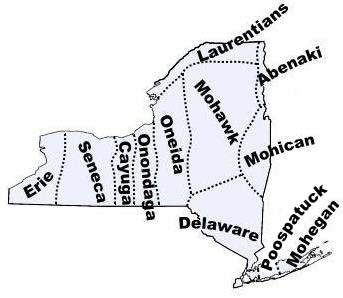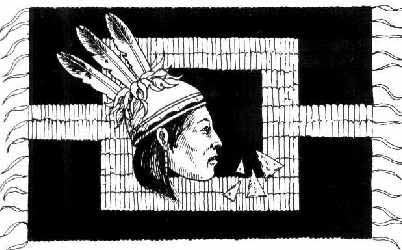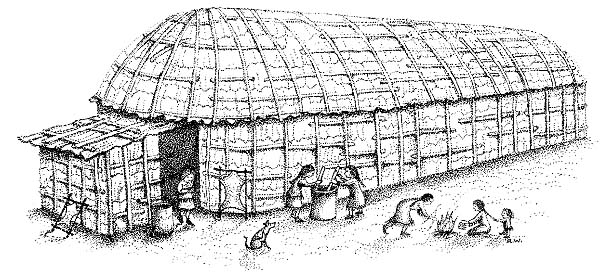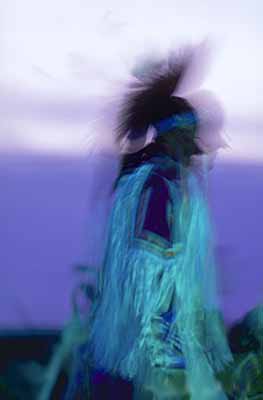



The Mohawk Indian tribe was one of the original members of the Iroquois Confederation, or Kanonsionni in their own language "people of the longhouse."

The other member nations were the Seneca, Oneida, Cayuga, and the Onondaga. Later a sixth tribe, the Tuscarora, joined the confederacy. Today these long-term allies refer to themselves as the Haudenosaunee or Six Nations.
The Kanienkehaka, or Mohawk tribe of Native American people live around Lake Ontario and the St. Lawrence River in what is now Canada and the United States. Their traditional homeland is further South, in New York State, around present day Albany, New York. They belong to the Iroquois confederation. After the pre-historic formation of the Iroquois confederation (Hodenosaunee), the Mohawks became keepers of the Eastern Door, guarding the members against invasions from that direction.
During the 17th century, the Mohawks became allied with the Dutch at Fort Orange, New Netherland (now Albany, New York). Their Dutch trade partners equipped the Mohawks to fight against other nations allied with the French, including the Ojibwes, Huron-Wendats, and Algonkins. After the fall of New Netherland to the English, the Mohawks became allies of the English Crown.
Because of ongoing conflict with Anglo-American settlers infiltrating into the Mohawk Valley and outstanding treaty obligations to the Crown, the Mohawks generally fought against the United States during the American Revolutionary War, the War of the Wabash Confederacy, and the War of 1812. After the Americans' victory, one prominent Mohawk leader, Joseph Brant, led a large group of Iroquois out of New York to a new homeland at Six Nations of the Grand River, Ontario.
On November 11, 1794, representatives of the Mohawks (along with the other Haudenosaunee nations) signed the Treaty of Canandaigua with the United States.
One large group of Mohawks, who were expelled by the United States as traitors were given land by the British Governor Craig and imposed to French speaking Quebecois who were refused new land because of not being English. They stayed in the vicinity of Montreal, where they served as the mercenaries of the British army. One of the most famous Catholic Mohawks was Kateri, who was later beatified. From this group descend the Mohawks of Kahnawake, Akwesasne and Kanesatake.
Members of the Mohawk tribe now live in settlements spread throughout New York State and Southeastern Canada. Among these are Ganienkeh and Kanatsiohareke in Northeast New York, Akwesasne/St.Regis along the Ontario-New York State border, Kanesatake/Oka and Kahnawake/Caughnawaga in southwest Quebec, and Tyendinaga and Wahta/Gibson in southern Ontario. Mohawks also form the majority on the mixed Iroquois reserve, Six Nations of the Grand River, in Ontario.
Many Mohawk communities have two sets of chiefs that exist in parallel and are in some sense rivals. One group are the hereditary chiefs nominated by clan matriarchs in the traditional fashion; the other are elected chiefs with whom the Canadian and US governments usually deals exclusively.
Since the 1980s, Mohawk politics have been driven by factional disputes over gambling. Both the elected chiefs and the controversial Warrior Society have encouraged gaming as a means of ensuring tribal self-sufficiency on the various reserves/reservations, while traditional chiefs have opposed gaming on moral grounds and out of fear of corruption and organized crime.
Such disputes have also been associated with religious divisions: the traditional chiefs are often associated with the Longhouse tradition, while Warrior Society has attacked that religion in favor of the pre-Longhouse Old tradition.
Meanwhile, the elected chiefs have tended to be associated (though in a much looser and general way) with democratic values. The Government of Canada who ruled the Indians imposed English school and separated families to place children in english boarding school. Mohawks like in other tribes have lost their native language and many left the reserve to mesh with the English Canadian culture.
The Mohawks, like many indigenous tribes in the Great Lakes region, wore a type of hair style in which all their hair would be cut off except for a narrow strip down the middle of the scalp. Today such a hair style is still called a Mohawk.
The Mohawk nation had a tribal council chosen by the Mohawk clan mothers (matriarchs, or female leaders.) But the Mohawks were also subject to the decisions made by the Iroquois Great Council. Nine Mohawk chiefs represented their tribe's interests in the Iroquois Council. This is similar to American states which each have their own government, but are all subject to the US government. In fact, the Iroquois Confederacy was one of the examples of representative democracy used as a model by America's founding fathers.
Today the Mohawk people have four First Nations in what is now Ontario and Quebec, including one reservation with land on both sides of the Canada-US border. Each of these Mohawk tribes is autonomous, which means the Indians who live there have the right to make their own government and laws. There are also other Mohawk communities in New York and Quebec, and some Mohawk people live on the Six Nations Reserve, which they share with members of the other Iroquois nations.
Most people believe that the Mohawks, like some indigenous tribes in the Great Lakes region, sometimes wore a hair style in which all their hair would be cut off except for a narrow strip down the middle of the scalp from the forehead to the nape, that was approximately three finger widths across.[citation needed] However this is not correct and the idea that Mohawks had "Mohawk hairstyles" the narrow strip of hair down the middle of the head from forehead to nape of the neck came from Hollywood and more specifically "Drums Along the Mohawk".The true hairstyle of the Mohawk including the entire Six Nations was to pluck the hair out of the head (not shaven), tuft by tuft of hair until all that was left was a square of hair on the back crown of the head. The hair that was left, was shortened so that three short braids of hair were created and those braids were highly decorated. This is the true "Mohawk" hairstyle and not the Hollywood version taken from the Pawnee.
The women wore their hair long often with traditional bear grease or tied back into a single braid. Their heads were often not covered by a covering or hat, often wearing nothing on their heads in winter.
Traditional dress styles of the Kanien'keha:ka Mohawk peoples consisted of women going topless in summer with a skirt of deerskin. In colder seasons, women wore a full woodland deerskin dress, leather tied underwear, long fashioned hair or a braid and bear grease. There was otherwise nothing on their head, except several ear piercings adorned by shell earrings, shell necklaces, and also puckered seam ankle wrap moccasins.
The women also used a layer of smoked and cured moss as an insulation absorbency for menses, as well as simple scraps of leather were used. Later menses use consisted of cotton linen pieces where pilgrim settlers and missionaries provided trade and introduced of such items.
The traditional dress styles of the Kanien'keha:ka Mohawk men consisted solely of a breech cloth of deerskin in summer, deerskin leggings and a full piece deerskin shirt in winter, several shell strand earrings, shell necklaces, long fashioned hair or a three finger width forehead-to-nape hair row which stood approximately three inches from the head and puckered seamed wrap ankle moccasins.
The men would also carry a quill and flint arrow hunting bag as well as arm and knee bands.
During the summer, traditional dress styles of the Kanien'keha:ka Mohawk children consisted of nothing up to the ages of thirteen, the time before they were ready for their warrior or woman passages or rites.[citation needed]
Later dress after European contact combined some cloth pieces such as the males ribbon shirt in addition to the place of the deerskin clothing, and wool trousers and skirts. For a time many Mohawk peoples incorporated a combination of the older styles of dress with newly introduced forms of clothing.
According to author Kanatiiosh in "Hodenasaunee Clothing and & Other Cultural Items" Mohawk as a part of the Hodenasaunee Confederacy: "Traditionally used furs obtained from the woodland, which consisted of elk and deer hides, corn husks, and they also wove plant and tree fibers to produce clothing".
Later Sinew or animal gut was cleaned and prepared as a thread for garments and footwear and was threaded to porcupine quills or sharp leg bones, in order to sew or pierce eyeholes for threading.
Clothing dyes were obtained of various sources such as berries, tree barks, flowers, grasses, sometimes fixed with urine.
Generally a village of Mohawk people wore the same design of clothing applicable to their gender, with individualized color and artwork designs incorporated onto the clothing and moccasins. Durable clothing that was held by older village people and adults was handed down to others in their family sometimes as gifts, honors, or because of outgrowth.
Mohawk clothing was sometimes reminiscent of designs from trade with neighboring First Nation tribes, and was more closely in resemblance to that of other Six Nations confederacy nations however much originality applicable to the Mohawk nation peoples style of dress was often kept as the foundation of the style they wore.
Mohawk Nation wedding ceremonies are conducted by a chief, since the chief holds the sanction to perform the greatest rituals before the Creator. In a marriage, the couple vow their commitment before the Creator. The marrying man and woman then unite in a lifelong relationship, and there is not any custom for divorce. This is not held as a punishment, however; the Mohawk Nation people are a matrilineal society and hold marriage as a great commitment which should be nurtured and respected. Much respect is given to the woman by her husband because the woman is the head of the household.
The traditional marriage ceremony included a day of celebration for the man and woman, a formal oration by the chief of the woman's nation and clan, community dancing and feast, and gifts of respect and honor by community members. Traditionally these gifts were practical which the couple would use in their everyday religious and working lives.
For clothing the man and woman wore white rabbit leathers and furs with personal adornments, usually made by their families, to stand apart from the rest of the community's traditional style of dress during the ceremony. The "Rabbit Dance Song" and other social dance songs were sung by the men, where they used gourd rattles and later cow-horn rattles. In the "Water Drum", other well-wishing couples participated in the dance with the couple. The meal would commence after the ceremony and everyone who participated would eat.
Today the marriage ceremony may follow that of the old tradition or incorporate newer elements, but it is still used by many Mohawk Nation marrying couples. In addition, there are couples who have chosen to marry in the European manner, as well as in the Longhouse manner, with the Longhouse ceremony usually being held first.
Women practiced corn (maize) agriculture while men hunted during the fall and winter and fished during the summer.
According to traditional accounts the Mohawk leader Hiawatha was the first to accept the principles of peace preached by the prophet of peace, Peacemaker, who founded the Iroquois League. The Mohawk had nine representatives in the league, three from each of their clans of the Turtle, Wolf, and Bear.
Each Mohawk community also had a local council that guided the village chief or chiefs.
Each Mohawk community also had a local council that guided the village chief or chiefs.
The Mohawk frequently warred against neighboring Algonkian tribes; the Dutch introduction of firearms in trade for beaver skins increased the number of Mohawk victories.
After contact with Europeans, however, their population decreased rapidly. Most Mohawk took the part of the British in the French and Indian War, but some Catholic converts (the "praying Indians of Quebec") at mission settlements on the St. Lawrence River, principally at Caughnawaga, espoused the French cause and guided expeditions against their former brothers of the league.
Later, during the American Revolution, the Mohawk were pro-British, under their leader Joseph Brant and followed him to Canada, where they have descendants at the Bay of Quinte and Six Nations Indian Reserve at Brantford, Ont.
Their total number in the late 20th century was about 5,000. Some are successful farmers, and others are workers in structural steel in the United States and Canada, traveling from city to city to find jobs.
The danger of this work seems to constitute part of its attraction for the Mohawk.
In 1614, the Dutch opened a trading post at Fort Nassau, New Netherland near present-day Albany, New York. The Dutch initially traded for furs with the local Mahican. In 1628, the Mohawk tribe defeated the Mahican, who retreated to Connecticut. The Mohawk gained a near-monopoly in the fur trade with the Dutch by not allowing the neighboring Algonquian-speaking tribes to the north or east to trade with them. The Dutch established trading posts at present-day Schenectady and Schoharie, further west in the Mohawk Valley.
The Mohawk and Dutch became allies. Their relations were peaceful even during the periods of Kieft's War and the Esopus Wars, when the Dutch fought localized battles with other tribes. The Dutch trade partners equipped the Mohawk to fight against other nations allied with the French, including the Ojibwe, Huron-Wendat, and Algonquin. In 1645 the Mohawk made peace with the French.
During the Pequot War (1634-1638), the Algonquian Indians of New England sought an alliance with the Mohawk. The Mohawk refused the alliance, killing the Pequot sachem Sassacus, who had come to them for refuge.
In the winter of 1651, the Mohawks attacked to the southeast and overwhelmed Algonquians in the coastal areas. They took between 500-600 captives. In 1664, the Pequot of New England killed a Mohawk ambassador, starting a war which resulted in the destruction of the Pequot. The Mohawks also attacked other members of the Pequot confederacy, in a war which lasted until 1671.
In 1666, the French attacked the Mohawk in the central New York area, burning all the Mohawk villages and their stored food supply. One of the conditions of the peace was that the Mohawks accept Jesuit missionaries. Beginning in 1669, missionaries attempted to convert many Mohawks from paganism to Christianity and relocate to two mission villages near Montreal. These Mohawks became known as Kahnawake (also spelled Caughnawaga) and they became allies of the French. Many converted to Catholicism at Kahnawake, the village named after them. One of the most famous Catholic Mohawks was Kateri Tekakwitha, who was later beatified.
After the fall of New Netherland to England, the Mohawks in New York became English allies. During King Philip's War, Metacom, sachem of the warring Wampanoag Pokanoket, decided to winter with his warriors near Albany in 1675. Encouraged by the English, the Mohawks attacked and killed all but 40 of the 400 Pokanokets.
From the 1690s, the Mohawks in the New York colony underwent a period of Christianization by Protestant missionaries. Many were baptized with English surnames while others were given both first and surnames in English.
During the era of the French and Indian War (also known as the Seven Years' War), Anglo-Mohawk partnership relations were maintained by men such as Sir William Johnson (for the British Crown), Conrad Weiser (on behalf of the colony of Pennsylvania), and Hendrick Theyanoguin (for the Mohawks). The Albany Congress of 1754 was called in part to repair the damaged diplomatic relationship between the British and the Mohawks.
During the second and third quarters of the 18th century, most of the Mohawks in the Province of New York lived along the Mohawk River at Canajoharie, a few lived at Schoharie, while the rest lived about 30 miles downstream at the Ticonderoga Castle also called Fort Hunter. The two settlements were traditionally called the Upper Castle and the Lower Castle. The Lower Castle was almost contiguous with Sir Peter Warren's Warrensbush. Sir William Johnson built his first house on the north bank of the Mohawk River almost opposite Warrensbush.
Because of unsettled conflicts with settlers encroaching into the Mohawk Valley and outstanding treaty obligations to the British Crown, Mohawks fought against the United States during the American Revolutionary War. Some prominent Mohawks, such as the sachem Little Abraham at Fort Hunter, remained neutral throughout the war. One man, Joseph Louis Cook, supported the Americans and received a commission from the Continental Congress. During this war, Johannes Tekarihoga was the leader of the Mohawks. Johannes Tekarihoga died about 1780. Catherine Crogan, wife of Mohawk war chief Joseph Brant, named her brother Henry Crogan as the new Tekarihoga. Mohawk Nation

Mohawk Prophecies